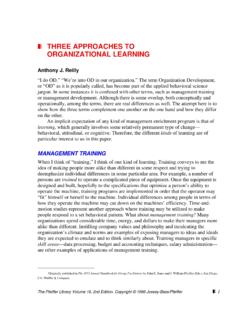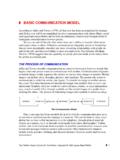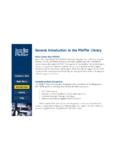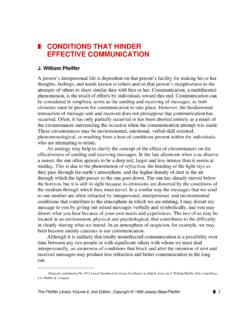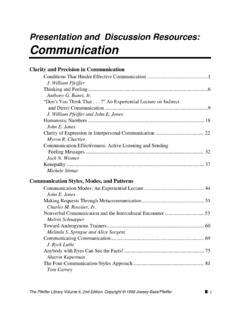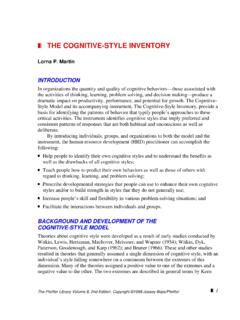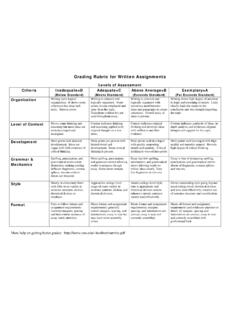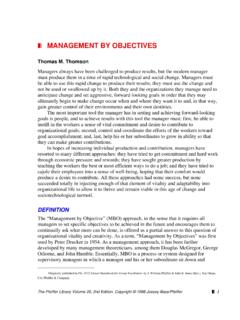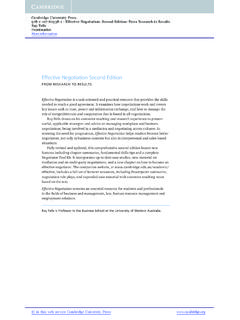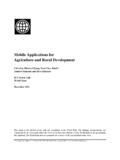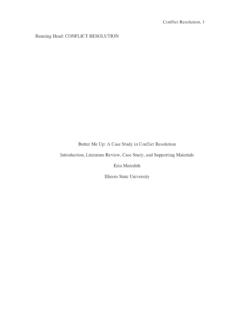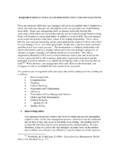Transcription of STRUCTURED EXPERIENCES, ROLE PLAYS, CASE STUDIES ...
1 The Pfeiffer Library Volume 21, 2nd Edition. Copyright 1998 Jossey-Bass/Pfeifferzx 1zxSTRUCTURED EXPERIENCES, ROLE PLAYS, case STUDIES , SIMULATIONS AND GAMES ATPFEIFFER & COMPANYE xperiential learning (learning by doing) is utilized more and more in the HRDcommunity. There is greater understanding that adult learning processes are differentfrom those of younger learners and that vehicles for learning other than the traditionallecture need to be utilized in order to promote adult learning. The purpose ofexperiential training is to let participants feel the learning as well as think it, to let them try on new behaviors and new emotional as well as cognitive are a number of different ways of changing people s attitudes and ofdeveloping individuals behavioral skills.
2 We will discuss five of them in this volume: STRUCTURED experiences, role plays, case STUDIES , simulations, and games. Thesetechnologies have been used and refined for decades, and they are still the mainstays ofmuch group experiences stress high participation and processing of data generatedduring interactive activities. Discussion also is a time-honored teaching intervention thathas been extended and refined in participation training. The case -study and gamingmethods, in which situations are acted out to some degree, are closely related to creating, adapting, and conducting experiential learning activities, the facilitatorneeds both a unifying theory and a practical translation of that thinking.
3 This section willexplore a variety of aspects of the technology, including a model for experientiallearning and design features that can be incorporated into a range of experientiallearning activities. The facilitator can use these ideas both in developing them and inmaking sure that preexisting ones fit the learning needs and readiness of a particulargroup at a particular urge the reader to consult the References and Bibliography listings at the endof this volume and to become acquainted with the sources listed there for furtherinformation and Pfeiffer Library Volume 21, 2nd Edition.
4 Copyright 1998 Jossey-Bass/Pfeiffer2 xzzxTHE EXPERIENTIAL LEARNING CYCLE: A MODELE xperiential learning occurs when a person engages in some activity, looks back at theactivity critically, abstracts some useful insight from the analysis, and puts the result towork through a change in behavior. Of course, this process is experienced spontaneouslyin everyone s ordinary life. We call it an inductive process: proceeding from observationrather than from a priori truth (as in the deductive process). Learning can be definedas a change in behavior as a result of experience or input, and that is the usual purposeof training.
5 A STRUCTURED experience provides a framework in which the inductiveprocess can be facilitated. The participants discover meaning for themselves andvalidate their own learning. The steps follow those of a theoretical Experiential Learning CycleEXPERIENCINGThe initial stage is the data-generating part of the STRUCTURED experience . It is the stepthat so often is associated with games or fun. Obviously, if the process stops after thisstage, all learning is left to chance, and the facilitator has not completed the task. Almostany activity that involves either self-assessment or interpersonal interaction can be usedas the doing part of experiential learning.
6 The following are common individual andgroup activities:The Pfeiffer Library Volume 21, 2nd Edition. Copyright 1998 Jossey-Bass/Pfeifferzx 3nmaking products or modelsncreating art objectsnwritingnrole playingntransactionsnsolving problems or sharing informationngiving and receiving feedbacknself-disclosurenfantasynchoosin gncommunicating verbally or nonverballynanalyzing case materialnnegotiating or bargainingnplanningncompeting or collaboratingnconfrontingThese activities can be carried out by individuals or in dyads (pairs), triads (trios), smallgroups, group-on-group arrangements, or large groups.
7 Of course, the learningobjectives would dictate both the activity and the appropriate is important to note that the objectives of STRUCTURED experiences are necessarilygeneral and are stated in terms such as to explore .. , to examine .. , tostudy .. , to identify .. , etc. Inductive learning means learning through discovery,and the exact things to be learned cannot be specified beforehand. All that is wanted inthis stage of the learning cycle is to develop a common data base for the discussion thatfollows. This means that whatever happens in the activity, whether expected or not,becomes the basis for critical analysis; participants may learn facilitators spend an inordinate amount of energy planning the activitybut leave the examination of it unplanned.
8 As a consequence, learning may not befacilitated. It is axiomatic that the next four steps of the experiential learning cycle areeven more important than the experiencing phase. Accordingly, the facilitator needs tobe careful that the activity does not generate excess data or create an atmosphere thatmakes discussion of the results difficult. There can be a lot of excitement and fun aswell as conflict in human interaction, but these are not synonymous with learning; theyprovide the common references for group Pfeiffer Library Volume 21, 2nd Edition. Copyright 1998 Jossey-Bass/Pfeiffer4 xzPUBLISHINGThe second stage of the cycle is roughly analogous to that of inputting data, in data-processing terms.
9 People have experienced an activity and now they presumably areready to share what they saw and/or how they felt during the event. The intent here is tomake available to the group the experience of each individual. This step involves findingout what happened within and to individuals at cognitive, affective, and behaviorallevels while the activity was progressing. A number of methods help to facilitate thepublishing, or declaring, of the reactions and observations of individual data during the experiencing stage (for later discussion): rating suchthings as productivity, satisfaction, confidence, communication, leadership, etc.
10 ;listing adjectives that capture feelings at various : quick free-association go-arounds on various topics concerning sharing: generating lists such as the double-entry one What Isaw/How I felt. nPosting: total-group input recorded on a newsprint flip : developing ratings of relevant dimensions of the activity, tallying andaveraging these : systematic interviewing of individuals about their experiencesduring the : a variation of the Guess Who? technique asking participants tonominate one another for roles they played during the experiencing pairs: asking one another what and how questions about can be carried out through unstructured discussion, but this requires thatthe facilitator be absolutely clear about the differences in the steps of the learning cycleand distinguish sharply among interventions in the discussion.
